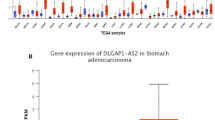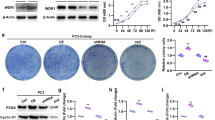Abstract
Glioblastoma multiforme (GBM) is the most aggressive type of brain tumor, characterized by excessive cell proliferation, resistance to apoptosis, and invasiveness. Due to resistance to currently available treatment options, the prognosis for patients with GBM is very dismal. The activation of gastrin-releasing peptide receptors (GRPR) stimulates GBM cell proliferation, whereas GRPR antagonists induce antiproliferative effects in in vitro and in vivo experimental models of GBM. However, the role of GRPR in regulating other aspects of GBM cell function related to tumor progression remains poorly understood, and previous studies have not used RNA interference techniques as tools to examine GRPR function in GBM. Here, we found that stable GRPR knockdown by a lentiviral vector using a short hairpin interfering RNA sequence in human A172 GBM cells resulted in increased cell size and altered cell cycle dynamics consistent with cell senescence. These changes were accompanied by increases in the content of p53, p21, and p16, activation of epidermal growth factor receptors (EGFR), and a reduction in p38 content. These results increase our understanding of GRPR regulation of GBM cells and further support that GRPR may be a relevant therapeutic target in GBM.






Similar content being viewed by others
References
Wen PY, Kesari S (2008) Malignant gliomas in adults. N Engl J Med 359:492–507
Maher EA, Furnari FB, Bachoo RM, Rowitch DH, Louis DN, Cavenee WK, DePinho RA (2001) Malignant glioma: genetics and biology of a grave matter. Genes Dev 15:1311–1333
Stupp R, Mason WP, van den Bent MJ, Weller M, Fisher B, Taphoorn MJ, Belanger K, Brandes AA et al (2005) Radiotherapy plus concomitant and adjuvant temozolomide for glioblastoma. N Engl J Med 352:987–996
Jensen RT, Battey JF, Spindel ER, Benya RV (2008) International Union of Pharmacology. LXVIII. Mammalian bombesin receptors: nomenclature, distribution, pharmacology, signaling, and functions in normal and disease states. Pharmacol Rev 60:1–42
Halmos G, Wittliff JL, Schally AV (1995) Characterization of bombesin/gastrin-releasing peptide receptors in human breast cancer and their relationship to steroid receptor expression. Cancer Res 55:280–287
Carroll RE, Matkowskyj KA, Chakrabarti S, McDonald TJ, Benya RV (1999) Aberrant expression of gastrin-releasing peptide and its receptor by well-differentiated colon cancers in humans. Am J Physiol 276(3 Pt 1):G655–G665
Markwalder R, Reubi JC (1999) Gastrin-releasing peptide receptors in the human prostate: relation to neoplastic transformation. Cancer Res 59:1152–1159
Sun B, Halmos G, Schally AV, Wang X, Martinez M (2000) Presence of receptors for bombesin/gastrin-releasing peptide and mRNA for three receptor subtypes in human prostate cancers. Prostate 42:295–303
Cornelio DB, Roesler R, Schwartsmann G (2007) Gastrin-releasing peptide receptor as a molecular target in experimental anticancer therapy. Ann Oncol 18:1457–1466
Cornelio DB, Meurer L, Roesler R, Schwartsmann G (2007) Gastrin-releasing peptide receptor expression in cervical cancer. Oncology 73:340–345
Flores DG, Meurer L, Uberti AF, Macedo BR, Lenz G, Brunetto AL, Schwartsmann G, Roesler R (2010) Gastrin-releasing peptide receptor content in human glioma and normal brain. Brain Res Bull 82:95–98
Mattei J, Achcar RD, Cano CH, Macedo BR, Meurer L, Batlle BS, Groshong SD, Kulczynski JM et al (2014) Gastrin-releasing peptide receptor expression in lung cancer. Arch Pathol Lab Med 138:98–104
Moody TW, Mahmoud S, Staley J, Naldini L, Cirillo D, South V, Felder S, Kris R (1989) Human glioblastoma cell lines have neuropeptide receptors for bombesin/gastrin-releasing peptide. J Mol Neurosci 1:235–242
Staley J, Coy DH, Jensen RT, Moody TW (1993) Solubilization and purification of bombesin/gastrin releasing peptide receptors from human cell lines. J Mol Neurosci 4:29–40
Pinski J, Schally AV, Halmos G, Szepeshazi K, Groot K (1994) Somatostatin analogues and bombesin/gastrin-releasing peptide antagonist RC-3095 inhibit the growth of human glioblastomas in vitro and in vivo. Cancer Res 54:5895–5901
Sharif TR, Luo W, Sharif M (1997) Functional expression of bombesin receptor in most adult and pediatric human glioblastoma cell lines; role in mitogenesis and in stimulating the mitogen-activated protein kinase pathway. Mol Cell Endocrinol 130:119–130
de Farias CB, Lima RC, Lima LO, Flores DG, Meurer L, Brunetto AL, Schwartsmann G, Roesler R (2008) Stimulation of proliferation of U138-MG glioblastoma cells by gastrin-releasing peptide in combination with agents that enhance cAMP signaling. Oncology 75:27–31
Flores DG, de Farias CB, Leites J, de Oliveira MS, Lima RC, Tamajusuku AS, Di Leone LP, Meurer L et al (2008) Gastrin-releasing peptide receptors regulate proliferation of C6 glioma cells through a phosphatidylinositol 3-kinase-dependent mechanism. Curr Neurovasc Res 5:99–105
de Oliveira MS, Cechim G, Braganhol E, Santos DG, Meurer L, de Castro CG Jr, Brunetto AL, Schwartsmann G et al (2009) Anti-proliferative effect of the gastrin-release peptide receptor antagonist RC-3095 plus temozolomide in experimental glioblastoma models. J Neurooncol 93:191–201
Flores DG, Ledur PF, Abujamra AL, Brunetto AL, Schwartsmann G, Lenz G, Roesler R (2009) Cancer stem cells and the biology of brain tumors. Curr Stem Cell Res Ther 4:306–313
Kiaris H, Schally AV, Sun B, Armatis P, Groot K (1999) Inhibition of growth of human malignant glioblastoma in nude mice by antagonists of bombesin/gastrin-releasing peptide. Oncogene 18:7168–7173
Qiao J, Kang J, Ishola TA, Rychahou PG, Evers BM, Chung DH (2008) Gastrin-releasing peptide receptor silencing suppresses the tumorigenesis and metastatic potential of neuroblastoma. Proc Natl Acad Sci U S A 105:12891–12896
Filippi-Chiela EC, Oliveira MM, Jurkovski B, Callegari-Jacques SM, da Silva VD, Lenz G (2012) Nuclear morphometric analysis (NMA): screening of senescence, apoptosis and nuclear irregularities. PLoS ONE 7, e42522
Giard DJ, Aaronson SA, Todaro GJ, Arnstein P, Kersey JH, Dosik H, Parks WP (1973) In vitro cultivation of human tumors: establishment of cell lines derived from a series of solid tumors. J Natl Cancer Inst 51:1417–1423
Sato Y, Kurose A, Ogawa A, Ogasawara K, Traganos F, Darzynkiewicz Z, Sawai T (2009) Diversity of DNA damage response of astrocytes and glioblastoma cell lines with various p53 status to treatment with etoposide and temozolomide. Cancer Biol Ther 8:452–457
Ciesielski MJ, Fenstermaker RA (2000) Oncogenic epidermal growth factor receptor mutants with tandem duplication: gene structure and effects on receptor function. Oncogene 19(6):810–820
Campisi J (2011) Cellular senescence: putting the paradoxes in perspective. Curr Opin Genet Dev 21:107–112
Ohtani N, Takahashi A, Mann DJ, Hara E (2012) Cellular senescence: a double-edged sword in the fight against cancer. Exp Dermatol 21(Suppl 1):1–4
Hirose Y, Berger MS, Pieper RO (2001) p53 effects both the duration of G2/M arrest and the fate of temozolomide-treated human glioblastoma cells. Cancer Res 61:1957–1963
Brennan CW, Verhaak RG, McKenna A, Campos B, Noushmehr H, Salama SR, Zheng S, Chakravarty D et al (2013) The somatic genomic landscape of glioblastoma. Cell 155:462–477
Courtois-Cox S, Jones SL, Cichowski K (2008) Many roads lead to oncogene-induced senescence. Oncogene 27(20):2801–2809
Garbers C, Kuck F, Aparicio-Siegmund S, Konzak K, Kessenbrock M, Sommerfeld A, Häussinger D, Lang PA et al (2013) Cellular senescence or EGFR signaling induces interleukin 6 (IL-6) receptor expression controlled by mammalian target of rapamycin (mTOR). Cell Cycle 12:3421–3432
Xu Y, Li N, Xiang R, Sun P (2014) Emerging roles of the p38 MAPK and PI3K/AKT/mTOR pathways in oncogene-induced senescence. Trends Biochem Sci 39:268–276
Coppola D, Balducci L, Chen DT, Loboda A, Nebozhyn M, Staller A, Fulp WJ, Dalton W et al (2014) Senescence-associated-gene signature identifies genes linked to age, prognosis, and progression of human gliomas. J Geriatr Oncol 5:389–399
Kulju KS, Lehman JM (1995) Increased p53 protein associated with aging in human diploid fibroblasts. Exp Cell Res 217:336–345
Campisi J, di d’Adda Fagagna F (2007) Cellular senescence: when bad things happen to good cells. Nat Rev Mol Cell Biol 8:729–740
Acknowledgments
This research was supported by the National Council for Scientific and Technological Development (CNPq; grant numbers 484185/2012-8 and 303276/2013-4 to R. R), the National Institute for Translational Medicine (INCT-TM), the Children’s Cancer Institute (ICI), the South American Office for Anticancer Drug Development, and the HCPA institutional research fund (FIPE/HCPA).
Author information
Authors and Affiliations
Corresponding author
Additional information
Pâmela Rossi Menegotto and Patrícia Luciana da Costa Lopez contributed equally to this work.
Rights and permissions
About this article
Cite this article
Menegotto, P.R., da Costa Lopez, P.L., Souza, B.K. et al. Gastrin-Releasing Peptide Receptor Knockdown Induces Senescence in Glioblastoma Cells. Mol Neurobiol 54, 888–894 (2017). https://doi.org/10.1007/s12035-016-9696-6
Received:
Accepted:
Published:
Issue Date:
DOI: https://doi.org/10.1007/s12035-016-9696-6




